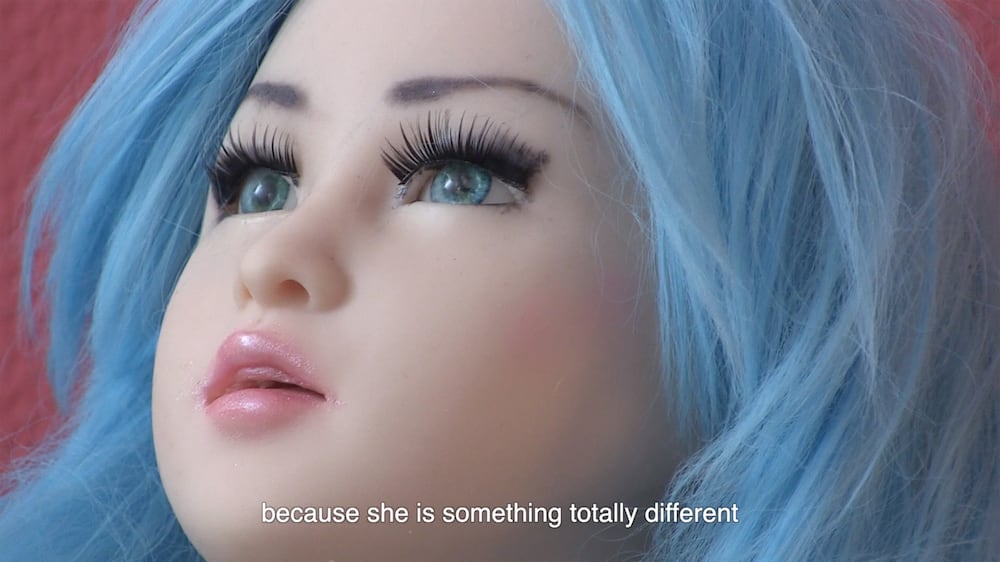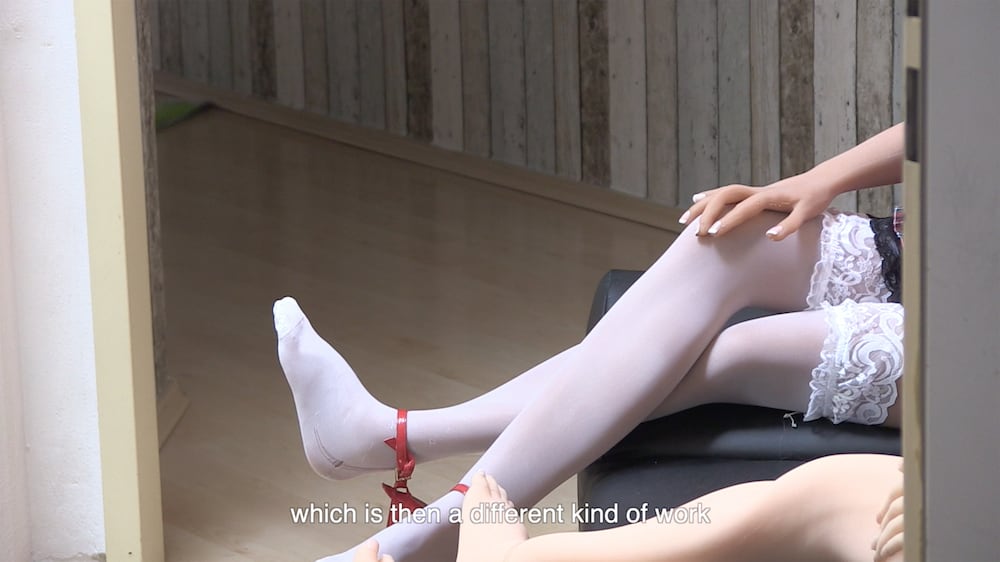

A woman in light blue jeans kneels over a sex doll. Its synthetic, rubbery legs are splayed across a bed as she casually probes its mouth with her fingers. A moment later she fields an enquiry on a cordless phone. ‘We usually go by appointments,’ she politely states in German, as she adjusts the doll’s white ‘stay up’ stockings. This scene introduces Maintenancer (2018), a thirteen-minute video work by Sidsel Meineche Hansen and Therese Henningsen that documents the labour required to clean and maintain sex dolls at the BorDoll brothel in Dortmund, Germany. Over the course of the video, we come to understand that a number of forms of feminised labour converge within this particular workplace. They are forms of labour that come under the category of social reproduction: cleaning, sex work and emotional labour.1 In this essay, I trace the way that care and emotional labour are shown to be significant aspects of sex work, as well as exploring the unorthodox ways in which care is manifested in Maintenancer.2 In recent years, artists and theorists have re-engaged with Marxist-feminist debates around reproductive labour — an important political category and terrain of social struggle. Maintenancer can be understood as part of this re-engagement, which is being driven by the state’s disinvestment from social welfare and the increasingly precarious living and working conditions in which artists and others find themselves.
The concept of social reproduction was pioneered by Marxist feminists in Western Europe and the United States in the 1970s. It provided a critique of orthodox Marxist analyses of labour, which neglected the home and the domestic sphere, where women were responsible for the majority of the work. The term social reproduction was used to describe the labour involved in bearing and caring for children, both vital activities for the existence of workers and wage labour. It also included the domestic, emotional and sexual tasks, typically performed by women for free within the home, that facilitated the well-being and rejuvenation of workers. Marxist feminists maintained that because of the role of labour power in producing surplus value, raising future workers and caring for the working class played a central role in capitalist accumulation. They fought against the social invisibility of domestic, emotional and care work and the ways in which their feminisation was entangled with naturalised ideas of women’s bodies. These objectives show social reproduction to be an important set of ideas through which to consider Maintenancer, as well as a body of thought that clearly informs the work. Recent theories of social reproduction take these earlier insights from the 1970s as their point of departure, but extend the concept to include paid reproductive work outside of the home, such as providing health care, care work and sex work.
Maintenancer shows Evelyn Schwarz, dominatrix and owner of BorDoll, and her anonymous assistant, as they go about their daily routines. We hear the two women speak of their experiences of running and working in the brothel, respectively, emphasising the multiple skills and personal attributes required to do so. The imagery zeroes in on the dolls and the everyday details of the brothel’s colourful interior. We see Schwarz’s assistant undertake a number of banal tasks: sweeping the floor, filling in paperwork, managing cash and preparing drinks. She diligently cleans and applies make-up to the brothel’s dolls, preparing them for the next client. In one particular scene, we are shown Angel after use. The doll’s pliable arms protrude awkwardly as Schwarz’s assistant leans over it, a box of disinfectant sprays at her side. She thoroughly cleans each of its orifices using wet wipes, inserting a black gloved hand in order to completely sterilise the doll. Next, she delicately touches up its vulva and nipples with make-up, clothes the doll, props it up and gently adjusts its lolling head. Despite the fact that the doll is an inanimate object, her actions betray an element of tenderness.
In a revealing segment of the video, Schwarz’s assistant discloses that in the past she worked as a doctor’s assistant and as a disability support worker in a care home, skills that she finds readily transferable to her role in the brothel. She explains that in the brothel she helps anxious clients to feel calm and relaxed, as she did in the doctor’s office. Yet, this scene does not naturalise notions of women as inherently caring. Instead, by uncovering similarities within these industries, it highlights the fact that care work and sex work are gendered and commodified within capitalist society, encouraging reflection on other parallels such as a pervasive lack of labour and citizenship rights. Underscoring these issues, we are later told by Schwarz as the camera surveys a selection of chains, belts and handcuffs glinting against a painted brick wall, is that sex workers in Germany have no access to social security payments if they lose their job. The assistant’s discussion of her employment history challenges our assumptions about care work, illuminating the exclusion of sex workers, and those working in the sex industry, from everyday understandings of care and emotional labour.
In her sociological study of paid sex, Temporarily Yours: Intimacy, Authenticity and the Commerce of Sex, Elizabeth Bernstein argues that the reorganisation of production which took place in the 1970s, typically understood as post-Fordism and characterised by flexibility, mobility and the dispersal of production, was accompanied by transitions within the field of paid sex.3 In her view, contemporary sex work is tied to the proliferation of service work, especially those forms understood as affective labour. Today, some sex workers offer a complete ‘girlfriend experience’ that includes providing an emotional connection alongside sexual services. While the example of the ‘girlfriend experience’ is a clear illustration of the emotional labour involved in one particular type of sex work, her study suggests that it is pervasive across the field.4 This is evident in Maintenancer, where emotional labour takes a number of forms: not only does the assistant dispel the anxiety of visitors, but Evelyn Schwarz also describes her S&M work as psychologically intensive. The emotional labour provided at BorDoll underlines the idea that sex work is a form of social reproduction, predominantly aimed at satisfying the needs of the male client or worker.5
**
Maintenancer documents one facet of the growing industry around post-human sex. Sex robots, first released in 2019, are based on dolls similar to those shown in the video. The robots, however, are equipped with a computerised head, capable of collecting data from their users. Inspired by this possibility and the disciplinary repercussions of new technologies on gender, sexuality, labour and the body, Maintenancer reflects artist Sidsel Meineche Hansen’s ongoing research into these issues. By the end of the video it is clear that the emotional labour involved in the sex industry will be impossible to fully replicate using robots, despite the neoliberal fantasy of doing so. And while the development of new technologies opens up a number of new possibilities for the sale of sex, the idea that robots can replace sex workers effaces the high level of emotional skill required by this gendered workforce. Schwarz touches on this idea at the end of the video, when she asserts: ‘Currently, I am unsure if the robots are intelligent enough ... At some point they will be ... But I wouldn’t be worried about this in the next twenty years.’
Viewing Maintenancer through the lens of social reproduction allows us to see that the power of the work rests in its capacity to give visibility to, and reflect upon, forms of labour that are gendered, marginalised and deeply stigmatised. Additionally, this type of analysis furthers our appreciation of the ways in which these forms of labour contribute to capitalist accumulation. Today the concept of care, which social reproduction encompasses and is closely related to, has also risen to prominence within art, activism and social theory. Here, the focus has frequently been on its potential to counter the pressures brought about by capitalism’s processes of accumulation through the creation of new ‘care communities’ and ‘reproductive commons’. Yet the problem remains — will the majority of this work continue to be carried out by women, even in cases where it is collectivised?6 When considering the burgeoning interest in the topic of care within art and curatorial practice, we should be aware of the risk of re-naturalising care as inherently the work of women. Maintenancer confronts this problem, complicating hegemonic notions of care by highlighting the emotional labour involved in sex work — a form of care work that is frequently overlooked in artistic representations and other discourses — and, perhaps even more profoundly, by focussing on the unusual and unexpected care provided to the sex dolls by Schwarz’s assistant.
